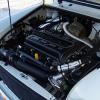What is the issue here? Oil out the dipstick or water in the catch can?
Oil out the dipstick hole is not uncommon, oil gets thrown up at the hole from the inside as the crank rotates. Ive seen people fit a spring from the distributor clamp up the ring in the dipstic to keep it firmly in place. No real biggie.
Water in the catch can is very common. The catch can is usually much much cooler than the engine. Air is drawn in through the crankcase via the various breathers especially when a hot engine cools down. The air holds a lot of moisture which condenses out inside the engine at this time of the year, the water then evaporates again as the engine warms up and leaves via the breathers. As the catch can is now the cold bit, the vapour condenses as water in the catch can.
The only realy way to determine engine condition is by a test called a leak down test, but the test AC Dodd suggested is nice and simple which will show the crankcase pressure in a running engine, you only need a simple manometer or small scale pressure gauge to see what pressure the crankcase is acheiving.
In the main, the breathers should be attached to the carb, as the engine consumes more air (high RPM under load) the slight depression in the carb positively draws the crankcase gasses out of the engine by the bernoulli effect. We are not talking a huge depression here, just enough to ventilate the crankcase. Hence the term 'positive' cankcase ventilation.
If the engine is performing well it is hardly likely that you have such a problem with the ring seal especially if its not consuming oil, remembering thay the old A series does use more oil than a modern engine. If you have lots of oil out of the breathers, which from what has been said, is not the case, may indicate a stronger possability of a heavy breathing engine. Some engines are just heavy breathers. i dont think you have anything to be concerned about, but that is simply a point of view since I have no way of assessing the engine for myself.
The breather cans do tend to get gummed up and present a greater resistance to gas flow even when they appear 'clear'. Any particularly aged ones would certainly benefit from a good soaking in a solvent cleaner (off the engine) and then blown through with air. Better still, new replacemwnts where available.
Also while here, the infamous 'mayo' does build up in breathers more so in winter and is not a sign of head gasket failure as some might suggest. Short journeys that dont allow the engine and oil to warm up fully for sufficiently long enough periods will see 'mayo' build up. That is just the condensed moisture from the air.
Edited by Sprocket, 29 January 2017 - 10:59 PM.























